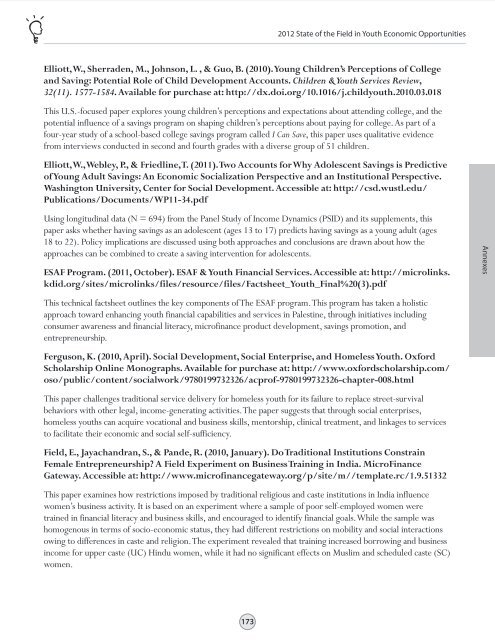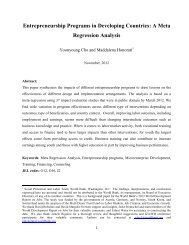STATE OF THE FIELD IN YOUTH ECONOMIC OPPORTUNITIES
STATE OF THE FIELD IN YOUTH ECONOMIC OPPORTUNITIES
STATE OF THE FIELD IN YOUTH ECONOMIC OPPORTUNITIES
You also want an ePaper? Increase the reach of your titles
YUMPU automatically turns print PDFs into web optimized ePapers that Google loves.
Table of Contents<br />
Chapter 1 Chapter 2 Chapter 3 Chapter 4 Chapter 5 Chapter 6 Chapter 7 Chapter 8<br />
Chapter 9<br />
Chapter 10 Chapter 11 Chapter 12 Chapter 13 Chapter 14 Chapter 15 Annexes<br />
2012 State of the Field in Youth Economic Opportunities<br />
Elliott, W., Sherraden, M., Johnson, L. , & Guo, B. (2010). Young Children’s Perceptions of College<br />
and Saving: Potential Role of Child Development Accounts. Children & Youth Services Review,<br />
32(11). 1577-1584. Available for purchase at: http://dx.doi.org/10.1016/j.childyouth.2010.03.018<br />
This U.S.-focused paper explores young children’s perceptions and expectations about attending college, and the<br />
potential influence of a savings program on shaping children’s perceptions about paying for college. As part of a<br />
four-year study of a school-based college savings program called I Can Save, this paper uses qualitative evidence<br />
from interviews conducted in second and fourth grades with a diverse group of 51 children.<br />
Elliott, W., Webley, P., & Friedline, T. (2011). Two Accounts for Why Adolescent Savings is Predictive<br />
of Young Adult Savings: An Economic Socialization Perspective and an Institutional Perspective.<br />
Washington University, Center for Social Development. Accessible at: http://csd.wustl.edu/<br />
Publications/Documents/WP11-34.pdf<br />
Using longitudinal data (N = 694) from the Panel Study of Income Dynamics (PSID) and its supplements, this<br />
paper asks whether having savings as an adolescent (ages 13 to 17) predicts having savings as a young adult (ages<br />
18 to 22). Policy implications are discussed using both approaches and conclusions are drawn about how the<br />
approaches can be combined to create a saving intervention for adolescents.<br />
ESAF Program. (2011, October). ESAF & Youth Financial Services. Accessible at: http://microlinks.<br />
kdid.org/sites/microlinks/files/resource/files/Factsheet_Youth_Final%20(3).pdf<br />
This technical factsheet outlines the key components of The ESAF program. This program has taken a holistic<br />
approach toward enhancing youth financial capabilities and services in Palestine, through initiatives including<br />
consumer awareness and financial literacy, microfinance product development, savings promotion, and<br />
entrepreneurship.<br />
Ferguson, K. (2010, April). Social Development, Social Enterprise, and Homeless Youth. Oxford<br />
Scholarship Online Monographs. Available for purchase at: http://www.oxfordscholarship.com/<br />
oso/public/content/socialwork/9780199732326/acprof-9780199732326-chapter-008.html<br />
This paper challenges traditional service delivery for homeless youth for its failure to replace street-survival<br />
behaviors with other legal, income-generating activities. The paper suggests that through social enterprises,<br />
homeless youths can acquire vocational and business skills, mentorship, clinical treatment, and linkages to services<br />
to facilitate their economic and social self-sufficiency.<br />
Field, E., Jayachandran, S., & Pande, R. (2010, January). Do Traditional Institutions Constrain<br />
Female Entrepreneurship A Field Experiment on Business Training in India. MicroFinance<br />
Gateway. Accessible at: http://www.microfinancegateway.org/p/site/m//template.rc/1.9.51332<br />
This paper examines how restrictions imposed by traditional religious and caste institutions in India influence<br />
women’s business activity. It is based on an experiment where a sample of poor self-employed women were<br />
trained in financial literacy and business skills, and encouraged to identify financial goals. While the sample was<br />
homogenous in terms of socio-economic status, they had different restrictions on mobility and social interactions<br />
owing to differences in caste and religion. The experiment revealed that training increased borrowing and business<br />
income for upper caste (UC) Hindu women, while it had no significant effects on Muslim and scheduled caste (SC)<br />
women.<br />
Annexes<br />
173

















